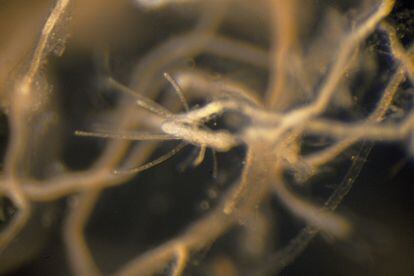In an effort to understand what makes one species functionally eternal, researchers have just matched its DNA to that of its mortal relatives.
Only one species, Turritopsis dohrnii, (which we introduced here) is known to have found the secret of eternal life. Now scientists have compared T. dornii’s DNA with its close relative, T. rubra, in hope of shedding light on how the aging process works and how we could evade it.

When T. dohrnii turn old they revert themselves back to their juvenile state. Yes, like hitting the restart button. Once the adults have reproduced, they don’t die unlike other common jellyfish. Instead, they transform themselves back into their juvenile polyp state, and the cycle starts again – and keeps happening, possibly indefinitely. Known as life cycle reversal (LCR), this happens as many times as the animal desires.
Researchers at Universidad de Oviedo in Spain have just published research results in the journal Proceedings of the National Academy of Sciences that could explain how T. dohrnii is able to live, at least in theory, forever. To find out, they took samples and performed whole genome sequencing of the immortal jellyfish. Once having the full genome, the same process was conducted with a very close relative of T. dohrnii, Turritopsis rubra, which is not immortal. Then the team looked for the differences in the genomes that allowed one to live forever and made the other perish.

Lead author Dr Maria Pascual-Torner and co-authors didn’t discover any single genetic trick that could provide eternal life. Nonetheless, they pinned down a wide range of potential contributors, reporting, “We have identified variants and expansions of genes associated with replication, DNA repair, telomere maintenance, redox environment, stem cell population, and intercellular communication.”
The researchers found that, besides having double the number of genes associated with gene repair and protection as T. rubra, the immortal T. dohrnii also had mutations allowing for stunting cell division and for preventing telomeres from breaking down. Furthermore, the researchers note that during the time when the jelly was metamorphosizing, some development-related genes reverted back to the state when the jelly was just a polyp – this kind of life cycle reversal was also absent from the T. rubra’s genome.

Applying these findings to humans won’t be an easy task, if it’s possible at all. But while many of T. dorhnii’s features probably only work in combination, some might provide a few precious extra years of health, even for us.
As the paper notes: “Natural selection declines with age,” which means that living long and healthy lives after one isn’t able to reproduce anymore doesn’t have much evolutionary benefits. Consequently, it rarely happens in nature and we only have T. dorhnii to guide us in making it happen ourselves.

Even T. dohrnii does not live forever though. In fact, it has a much shorter life expectancy than us, which is the fate of most small lifeforms with few defenses that jellyfish and fish find tasty. So, even though its capacity for rejuvenation makes it theoretically capable of living forever, the immortal jellyfish still has not come to dominate the Earth as we might expect from an immortal species. Luckily for us? Well, who knows…
Source: https://kenhthoisu.net







